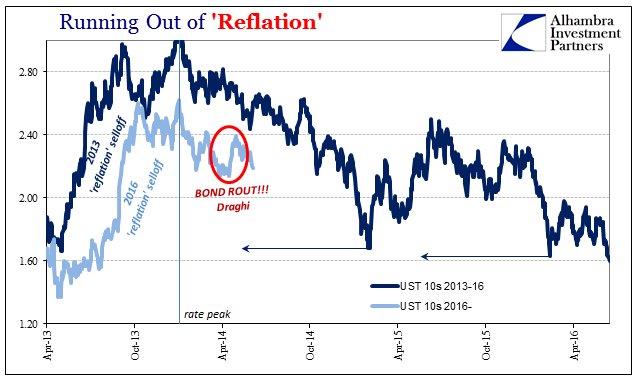Running Out Of TIC 'Reflation'
Adding to the FOMC’s general inflation confusion about money and economy, all the major factors it is supposed to be competent about, policymakers are also having trouble figuring out why as they raise rates overall financial conditions haven’t actually tightened.
According to one view, the easing of financial conditions meant that the economic effects of the Committee’s actions in gradually removing policy accommodation had been largely offset by other factors influencing financial markets, and that a tighter monetary policy than otherwise was warranted.
They don’t specify, of course, what counts as “financial conditions” but broadly speaking it isn’t difficult or unreasonable to assume. This “hawkish” view has been overwhelmed by the unfolding inflation debacle, though it nonetheless contributes to the general sense of “something” else going on.
The FOMC might look no further than the Treasury Department for answers and clues. The Treasury International Capital (TIC) data for June 2017 released today provides some of the missing analysis.
For the first part, the Official sector bought quite a lot of UST’s and other dollar denominated assets in June. After heavy selling in May, that was partially offset the following month. The net buying of UST’s especially in this part of the system does not suggest anything other than how foreign officials perceive “dollar” conditions in their local markets.
If they are on net selling fewer UST’s as they have been this year, it would indicate exactly what the FOMC is talking about as “offset by other factors influencing financial markets.” These overseas governments and central banks have not, however, given up on “selling UST’s”, they are merely selling fewer combined each quarter. Dollar pressure is not gone, it is just to some degree less which equals (second derivatives matter) “looser” global money.


That’s the good news for as far as it might go (confusing the FOMC is for the rest of us a good thing if for no other reason than to further demonstrate that they really don’t know what they are doing). The bad news is that what really drives global “dollar” conditions may no longer suggest “unaccounted” loosening.
Bank’s own dollar liabilities, one estimate of cross border funding levels in traditional dollars, renewed the downturn in Q2 2017. After rising for a second straight quarter in Q1, and by the largest amount since the first half of 2014 before the start of the “rising dollar”, liabilities contracted by a small amount in Q2.


This resulted despite the possible end of what had become a dependable pattern of quarter-end window dressing. For the month of June alone, reported liabilities declined by the smallest amount since 2013. It was instead the other two months of the quarter which were far less than similar months in those past quarters.

We may have already witnessed the effects of this possible negative shift in global “dollar” availability in places like swap spreads (though a lagging indication, the 10s have failed to follow up on Q1’s decompression) and perhaps collateral flow (WTI’s relationship with T-bill yields and dealer hoarding after March).


Because we don’t know yet how or if the pattern in bank liabilities changed, it’s difficult to determine to what extended degree this (possible) variation should be taken. Trading in UST’s or eurodollar futures as well as those displayed above are consistent with it being more than cosmetic. They indicate that the FOMC may not have much longer to wait before misunderstood “loosening” disappears and global “dollar” tightening, which many will mistakenly attribute to “rate hikes”, potentially re-emerges.
It may have, in fact, already started. That, too, is consistent with policy history as Federal Reserve officials are always the last to figure these things out. It took them, after all, until the summer of 2016 to finally get that the “rising dollar” might be a serious problem.
In any case, the TIC data on the banking side adds to the increasingly negative monetary picture of repo markets as well as derivatives. It’s not yet a warning of anything imminent, but it is a reminder that the eurodollar system still doesn’t work (and that we might expect further economic and financial consequences from that).


Disclosure: This material has been distributed fo or informational purposes only. It is the opinion of the author and should not be considered as investment advice or a recommendation of any ...
more


